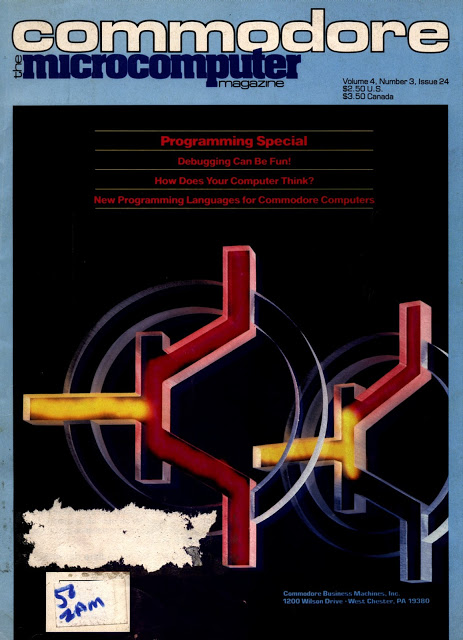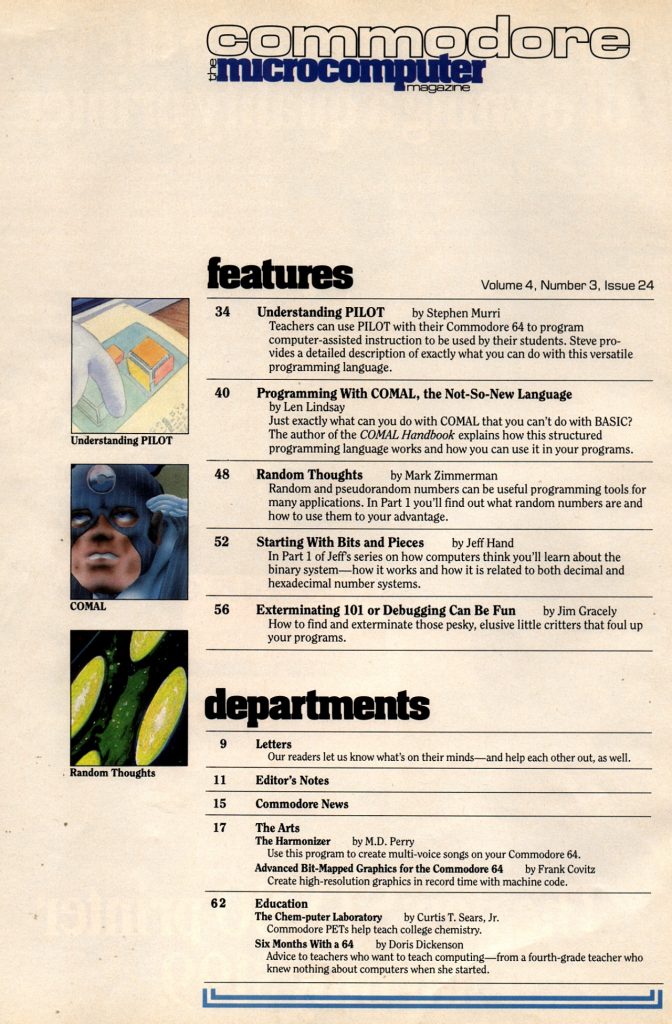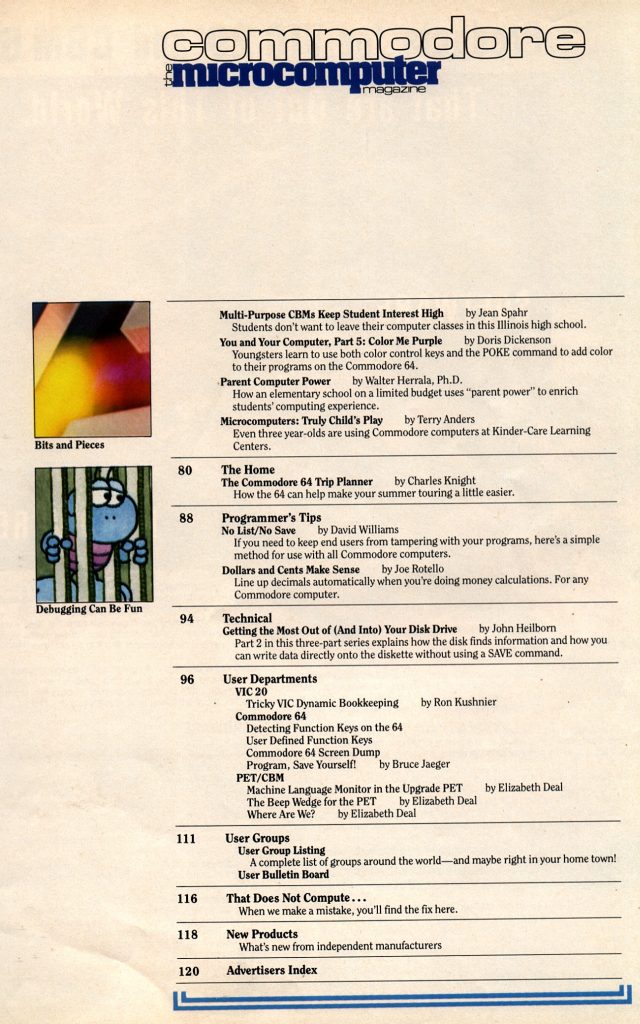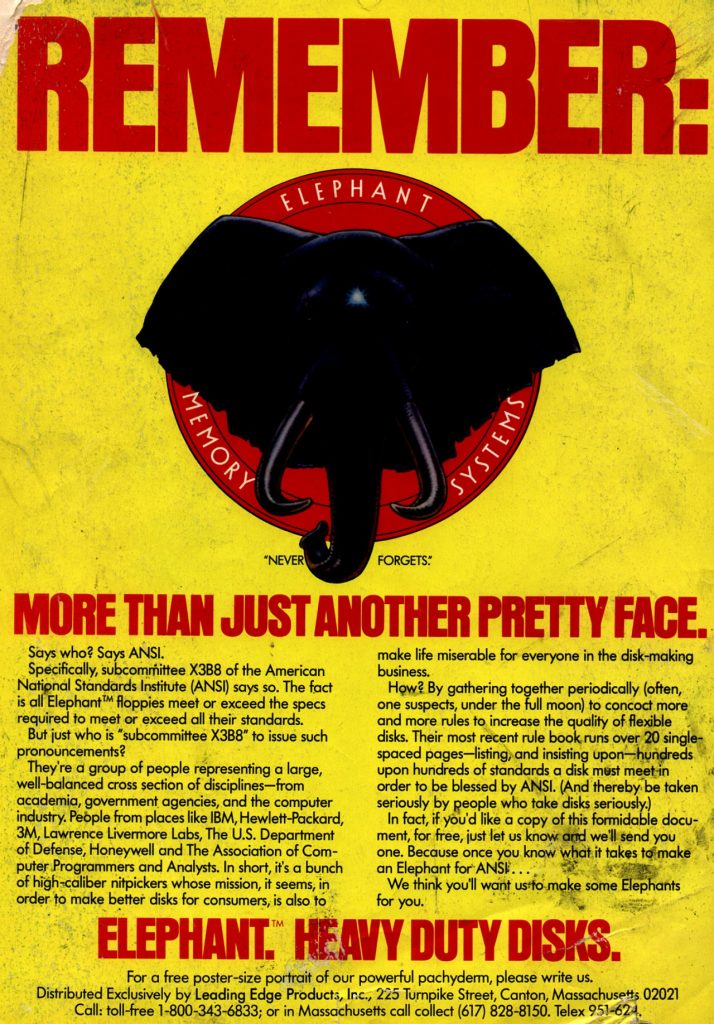Ahoy! was one of several popular Commodore specific magazines from the 1980s. It covered various computers depending on the time period but in 1984 it was primarily the VIC-20 and Commodore 64 that were featured. Interestingly, Ahoy! used the same cover scheme through most (if not all) of its life. There were always nine “monitors” on the cover and in each one was something to do with what was in the magazine. The July 1984 issue includes:
Departments
- A View from the Bridge – An overview of this month’s issue which includes a disk drive review, Database buyer’s guide, user group feature and more.
- Scuttlebutt – News and new products including the Cardco LQ/1 dot matrix printer for $649.95, LQ/3 for $449.95, the daisy wheel LQ/2 for $349.95, the Amdek 5025 dot matrix printer ($799), 5040 ($1675), and 5055 ($1990), a 64K memory expansion for the Commodore 64 from LETCO ($139.95) and much more including lots of new games.
- Flotsam – Letters from readers including corrections and additions related to previous articles, a question about using the Commodore 64 for a home business, and more.
- Book Review – A review of ‘The Working Commodore 64’ by David Lawrence.
- Commodares – Programming challenges submitted by readers including unscrambling words, counting letters, etc.
- Reviews – Reviews of various Commodore 64 and VIC-20 software.
- IFR (Flight Simulator) – A flight simulator for both the Commodore 64 and VIC-20 by Academy Software.
- Early Games for Young Children (Commodore 64) – A package of educational programs for preschoolers.
- The Game Show (Commodore 64) – A computerized version of the TV game show Password.
- The Voyage of the Mayflower (Commodore 64) – A strategy game in which you must lead the Mayflower to the New World.
- C.A.R.S. (Commodore 64, VIC-20) – Short for Car Analysis Reporting System, this program helps you keep track of car related maintenance and expenses.
- Mouthpiece (Commodore 64) – A more full-featured terminal program than had typically been available for the C64 up to that point.
- The Insta-Family (Commodore 64) – A rather primitive ‘office suite’ for the Commodore 64.
- Superbase 64 (Commodore 64) – A well reviewed database management system for the Commodore 64. I remember having this but didn’t use it for a whole lot.
- Falconian Invaders/Lazer Cycles/Maze Man/Ultrex Quadro Maze/Tyler’s Dungeons (Commodore 64) – A series of low budget games for the C64.
- Kidwriter (Commodore 64) – A unique program for kids ages 6-10 that allows them to create storybooks with graphics and text.
Features
- Creating Your Own Games – Some tips on creating your own games from Orson Scott Card.
- Starting or Joining a Users Group – Long before the Internet was readily accessible, if you wanted to learn more about your computer, get public domain software, etc. then a users group was one of the best ways to do it.
- Database buyer’s Guide – An overview of database software for the Commodore 64 and VIC-20 along with their features. There were quite a wide variety of choices including: Inquire Pac (C64), Data Base Manager (VIC-20, C64), Data Manager I (C64), Datalog (C64), Datman (C64), Delphi’s Oracle (C64), Filing Assistant (C64), Flex File (C64), Info-Manager (C64), Inventory (VIC-20, C64), Insta-File (C64), M’File (C64), Magpie (C64), Mail Now (C64), Mail Pro (C64), Mini Jini (VIC-20, C64), Omnifile (VIC-20, C64), Powerfile (C64), Rabbit Base (VIC-20), Record Keeper (C64), Research Assistant (VIC-20, C64), SDB-64 (C64), Simplifile (VIC-20), Superbase 64 (C64), TOTL. Infomaster (C64), TOTL. Label (VIC-20, C64), and Your Filing System (VIC-20, C64).
- Training Your Cursor – How to move the cursor around programatically. Includes examples.
- The MSD Dual Disk Drive: In-depth Report – This was a dual disk drive system for the Commodore 64 that was more expensive than two individual drives. However, one advantage was that since these drives shared a controller, copying data from disk to disk could be done without passing through the C64 itself making for much faster copying.
- The Rupert Report – All about files and sequential files in particular. Examples are given for creating and writing to SEQ files.
- Educational Software Guide, Part V – Part 5 of a guide designed for parents presenting an overview of available educational software. This part summarizes a variety of reading, drawing, and other educational programs.
Programs
- What’s My Job? – This type-in program will guess your job after you answer a series of questions.
- Checklist – This type-in program lets you create checklists with items to be checked off.
- Renumbering Utility – Renumbers your BASIC programs. Useful after you have created a program like 10 Print “test”, 20 GOTO 10, and then realize you need at least 11 steps in between…
- Brisk – A type-in program that gives you a card game that can be played vs. the computer.
- Math Defender – This type-in program is kind of like Missile Command except that you must enter the correct answer to shoot down the incoming math problem. There are both C64 and VIC-20 versions here.
…and more!






